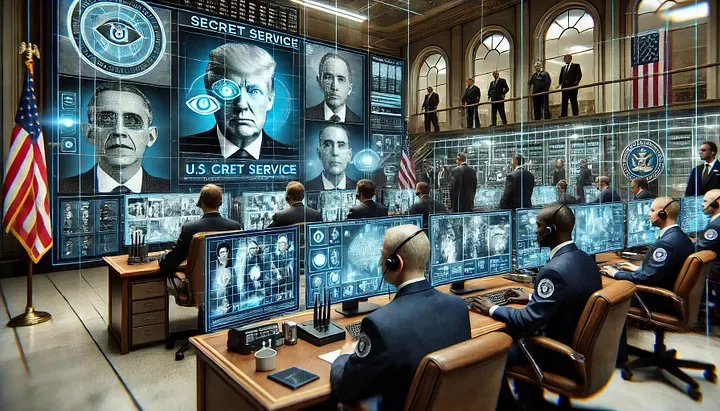AI Helping the Secret Service to Better Protect their AI Helping the Secret Service to Better Protect their Protectees

Artificial intelligence is pivotal in bolstering the U.S. Secret Service’s protective measures for the President and other high-profile protectees. Leveraging machine learning, computer vision, natural language processing, and data analytics, AI introduces innovative solutions that ramp up protective measures’ efficiency, accuracy, and responsiveness.
One of the primary applications of AI in protecting the President is through enhanced surveillance and threat detection. AI-powered surveillance systems can analyze vast amounts of video data in real-time, identifying suspicious activities or potential threats that human operators might miss. These systems use facial recognition technology to track individuals in crowds, cross-referencing with databases to flag known threats or persons of interest. Additionally, behavior analysis algorithms can detect unusual or potentially dangerous behaviors, prompting immediate alerts for further investigation.
AI is not just about surveillance; it’s also a potent tool for strengthening cybersecurity measures for the Secret Service. In an era of increasing digital reliance and cyber threats, AI-driven cybersecurity tools can swiftly detect and neutralize hacking attempts, phishing attacks, and other forms of cyber intrusion. By constantly monitoring network activity and learning from past attacks, these systems can predict and prevent potential breaches, ensuring the security of sensitive information and communication channels.
AI is not just about reacting to threats; it’s also about proactively enhancing the Secret Service’s logistical and operational planning. AI algorithms can analyze historical data, current threat levels, and environmental factors to optimize security protocols and resource allocation. For instance, predictive analytics can help anticipate potential security challenges during public appearances or travel, enabling more effective deployment of personnel and equipment. This proactive approach can significantly reduce vulnerabilities and enhance overall preparedness.
Another critical area where AI can assist is in emergency response and decision-making. AI systems can provide real-time data analysis and recommendations in high-pressure situations, helping agents make informed decisions quickly. For example, during an unexpected security breach, AI can analyze various scenarios and suggest the best action, whether it involves evacuation, neutralizing the threat, or other protective measures. This capability can be crucial in minimizing risks and ensuring the President’s and other protectees’ safety.
Moreover, AI can be integrated into communication systems to enhance coordination and information sharing among security teams and agencies. Natural language processing tools can analyze and interpret communication data, filtering out irrelevant information and highlighting critical details. This ensures that all relevant personnel receive timely and accurate information, facilitating better coordination and quicker response times.
AI’s potential in personalizing protection strategies is a key aspect that should not be overlooked. By analyzing data on the habits, routines, and preferences of protectees, AI can tailor security measures to their specific needs. This includes customizing surveillance patterns, adjusting security perimeters, and planning travel routes that minimize risk exposure. Such personalized protection strategies can significantly enhance the effectiveness of security efforts while maintaining the protectees’ comfort and convenience.
However, while integrating AI into the Secret Service’s operations offers numerous benefits, it also presents challenges. Issues such as data privacy, the potential for algorithmic bias, and the need for strong cybersecurity measures to protect AI systems themselves must be carefully addressed. Ensuring that AI tools are transparent, accountable, and used ethically is paramount to maintaining public trust and the integrity of the Secret Service’s mission.
AI can potentially revolutionize how the U.S. Secret Service protects the President and other high-profile individuals. By enhancing surveillance capabilities, improving cybersecurity, optimizing operational planning, and providing real-time decision support, AI can significantly bolster the effectiveness of protective measures. While challenges exist, with careful implementation and ethical considerations, AI can become an invaluable asset in ensuring the safety and security of the nation’s leaders.
Join Us Towards a Greater Understanding of AI
By following us and sharing our content, you’re not just spreading awareness but also playing a crucial role in demystifying AI. Your insights, questions, and suggestions make this community vibrant and engaging. We’re eager to hear your thoughts on topics you’re curious about or wish to delve deeper into. Together, we can make AI accessible and engaging for everyone. Let’s continue this journey towards a better understanding of AI. Please share your thoughts with us via email: marty@bearnetai.com, and don’t forget to follow and share BearNetAI with others who might also benefit from it. Your support makes all the difference.
Thank you for being a part of this fascinating journey.
BearNetAI. From Bytes to Insights. AI Simplified.
Categories: Artificial Intelligence (AI), National Security, U.S. Secret Service, Security and Screening, Emergency Response, Surveillance Technology, Cybersecurity, Operational Planning
The following sources are cited as references used in research for this BLOG post:
Cybersecurity and Cyberwar: What Everyone Needs to Know by P.W. Singer and Allan Friedman
The Fifth Domain: Defending Our Country, Our Companies, and Ourselves in the Age of Cyber Threats by Richard A. Clarke and Robert K. Knake
Predictive Analytics: The Power to Predict Who Will Click, Buy, Lie, or Die by Eric Siegel
Big Data: A Revolution That Will Transform How We Live, Work, and Think by Viktor Mayer-Schönberger and Kenneth Cukier
Data-Driven Security: Analysis, Visualization, and Dashboards by Jay Jacobs and Bob Rudis
© 2024 BearNetAI LLC